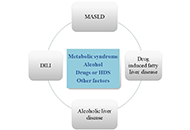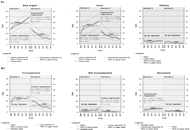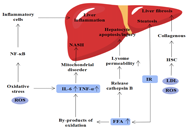Deciphering the liver enigma: distinguishing drug-induced liver injury and metabolic dysfunction-associated steatotic liver disease—a comprehensive narrative review
Drug-induced liver injury (DILI) poses a complex and heterogeneous clinical challenge, which often resembles non-drug related acute or chronic liver diseases, such as metabolic dysfunction-associate
[...] Read more.
Drug-induced liver injury (DILI) poses a complex and heterogeneous clinical challenge, which often resembles non-drug related acute or chronic liver diseases, such as metabolic dysfunction-associated steatotic liver disease (MASLD). Furthermore, certain drugs can induce hepatic steatosis, which is considered a rare variant of hepatotoxicity. Additionally, the detection and diagnosis of DILI in patients with non-alcoholic liver disease present additional challenges that require attention. The importance of achieving an accurate diagnosis is highlighted by the different therapeutic approaches needed for each of these diseases. Nonetheless, as definitive diagnostic tests and distinct biomarkers often remain elusive, the differential diagnosis must rely on a combination of clinical, biochemical, histological, and immunophenotypic profiling. The diagnosis of hepatotoxicity is predicated upon the temporal nexus between the administration of a potentially hepatotoxic drug and the onset of hepatic injury, concomitantly excluding alternative hepatic pathologies. More frequently, this condition presents an acute course, with a more pronounced elevation of cytolytic and cholestatic parameters as compared to fatty liver disease. Advances in elucidating the underlying mechanisms hold promise for bolstering the diagnosis and management of these conditions. This article aims to thoroughly examine and emphasize the currently available scientific evidence to provide valuable insights into the diagnostic strategies for DILI, metabolic-associated liver disease, and drug-induced steatosis (DIS).
Miren García-Cortés ... Alberto García-García
View:1631
Download:35
Times Cited: 0
Drug-induced liver injury (DILI) poses a complex and heterogeneous clinical challenge, which often resembles non-drug related acute or chronic liver diseases, such as metabolic dysfunction-associated steatotic liver disease (MASLD). Furthermore, certain drugs can induce hepatic steatosis, which is considered a rare variant of hepatotoxicity. Additionally, the detection and diagnosis of DILI in patients with non-alcoholic liver disease present additional challenges that require attention. The importance of achieving an accurate diagnosis is highlighted by the different therapeutic approaches needed for each of these diseases. Nonetheless, as definitive diagnostic tests and distinct biomarkers often remain elusive, the differential diagnosis must rely on a combination of clinical, biochemical, histological, and immunophenotypic profiling. The diagnosis of hepatotoxicity is predicated upon the temporal nexus between the administration of a potentially hepatotoxic drug and the onset of hepatic injury, concomitantly excluding alternative hepatic pathologies. More frequently, this condition presents an acute course, with a more pronounced elevation of cytolytic and cholestatic parameters as compared to fatty liver disease. Advances in elucidating the underlying mechanisms hold promise for bolstering the diagnosis and management of these conditions. This article aims to thoroughly examine and emphasize the currently available scientific evidence to provide valuable insights into the diagnostic strategies for DILI, metabolic-associated liver disease, and drug-induced steatosis (DIS).
 Deciphering the liver enigma: distinguishing drug-induced liver injury and metabolic dysfunction-associated steatotic liver disease—a comprehensive narrative reviewOpen AccessReviewDrug-induced liver injury (DILI) poses a complex and heterogeneous clinical challenge, which often resembles non-drug related acute or chronic liver diseases, such as metabolic dysfunction-associate [...] Read more.Miren García-Cortés ... Alberto García-GarcíaPublished: December 27, 2023 Explor Dig Dis 2023;2:318–336
Deciphering the liver enigma: distinguishing drug-induced liver injury and metabolic dysfunction-associated steatotic liver disease—a comprehensive narrative reviewOpen AccessReviewDrug-induced liver injury (DILI) poses a complex and heterogeneous clinical challenge, which often resembles non-drug related acute or chronic liver diseases, such as metabolic dysfunction-associate [...] Read more.Miren García-Cortés ... Alberto García-GarcíaPublished: December 27, 2023 Explor Dig Dis 2023;2:318–336 The significance of chronic hyperglycemia for the reduced efficacy of eradication therapy in patients with type 2 diabetes mellitus and for Helicobacter pylori survivalOpen AccessOriginal ArticleAim: This study aims to determine the significance of chronic hyperglycemia for the reduced efficacy of eradication therapy in patients with type 2 diabetes mellitus (T2DM) and Helicobacter pylor [...] Read more.Luiza Gilmanovna Bektemirova ... Vasiliy Ivanovich ReshetnyakPublished: December 27, 2023 Explor Dig Dis. 2023;2:305–317
The significance of chronic hyperglycemia for the reduced efficacy of eradication therapy in patients with type 2 diabetes mellitus and for Helicobacter pylori survivalOpen AccessOriginal ArticleAim: This study aims to determine the significance of chronic hyperglycemia for the reduced efficacy of eradication therapy in patients with type 2 diabetes mellitus (T2DM) and Helicobacter pylor [...] Read more.Luiza Gilmanovna Bektemirova ... Vasiliy Ivanovich ReshetnyakPublished: December 27, 2023 Explor Dig Dis. 2023;2:305–317 Impact of the direct acting antivirals on chronic hepatitis C prevalence on the Swiss organ transplantation list: a retrospective analysisOpen AccessOriginal ArticleAim: In Switzerland, the first access to interferon-free direct-acting antivirals (DAAs) for hepatitis C virus (HCV) treatment was in 2014. This study aimed to analyze the effects of DAAs on the [...] Read more.Luis Falcato ... Franz ImmerPublished: December 25, 2023 Explor Dig Dis. 2023;2:297–304
Impact of the direct acting antivirals on chronic hepatitis C prevalence on the Swiss organ transplantation list: a retrospective analysisOpen AccessOriginal ArticleAim: In Switzerland, the first access to interferon-free direct-acting antivirals (DAAs) for hepatitis C virus (HCV) treatment was in 2014. This study aimed to analyze the effects of DAAs on the [...] Read more.Luis Falcato ... Franz ImmerPublished: December 25, 2023 Explor Dig Dis. 2023;2:297–304 Therapeutic targets for metabolic dysfunction-associated steatotic liver disease and their roles in hepatocellular carcinomaOpen AccessReviewMetabolic dysfunction-associated steatotic liver disease (MASLD) is one of the most common chronic liver diseases. Over time, there has been a significant increase in the prevalence of MASLD. It has [...] Read more.Chenyu Wei ... Xianguang YangPublished: December 13, 2023 Explor Dig Dis. 2023;2:282–296
Therapeutic targets for metabolic dysfunction-associated steatotic liver disease and their roles in hepatocellular carcinomaOpen AccessReviewMetabolic dysfunction-associated steatotic liver disease (MASLD) is one of the most common chronic liver diseases. Over time, there has been a significant increase in the prevalence of MASLD. It has [...] Read more.Chenyu Wei ... Xianguang YangPublished: December 13, 2023 Explor Dig Dis. 2023;2:282–296